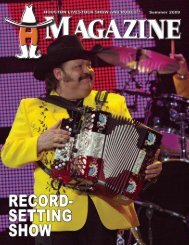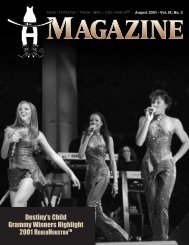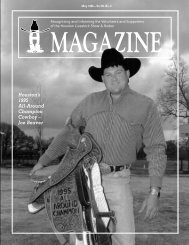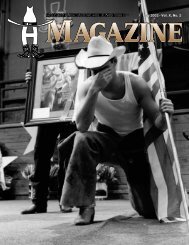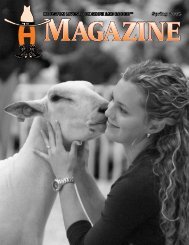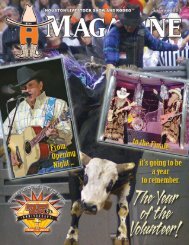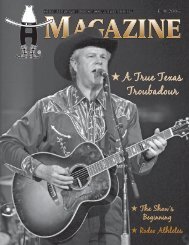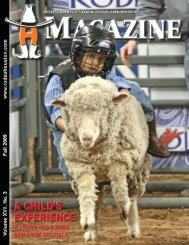Chairman of the Board - Houston Livestock Show and Rodeo
Chairman of the Board - Houston Livestock Show and Rodeo
Chairman of the Board - Houston Livestock Show and Rodeo
Create successful ePaper yourself
Turn your PDF publications into a flip-book with our unique Google optimized e-Paper software.
<strong>Show</strong> Me <strong>the</strong><br />
Bunnies!<br />
By Gina Steere<br />
6<br />
Every year, thous<strong>and</strong>s <strong>of</strong> visitors<br />
hop over to see <strong>the</strong> furry,<br />
lovable rabbits at <strong>the</strong> <strong>Houston</strong><br />
<strong>Livestock</strong> <strong>Show</strong>. Rabbits in<br />
Destination: AGVENTURE pack in<br />
eager visitors for <strong>the</strong> duration <strong>of</strong> <strong>the</strong><br />
<strong>Show</strong>. Some even are inspired to<br />
purchase a rabbit as a pet for <strong>the</strong><br />
entire family to enjoy. However,<br />
beyond a limited knowledge <strong>of</strong> rabbits<br />
as pets, <strong>the</strong> Easter Bunny <strong>and</strong><br />
<strong>the</strong> famous cartoon character named<br />
Bugs, many people are surprised to<br />
find out how much <strong>the</strong>re is to learn<br />
about rabbits <strong>and</strong> <strong>the</strong> many breeds<br />
that are shown competitively.<br />
The history <strong>of</strong> <strong>the</strong> American<br />
domesticated rabbit can be traced<br />
back to descendants <strong>of</strong> European<br />
wild rabbits. Credit for domestication<br />
<strong>of</strong> wild rabbits goes to <strong>the</strong> early<br />
French Catholic monks who benefited<br />
from <strong>the</strong> steady supply <strong>of</strong> food <strong>and</strong> fur. They selectively bred a rabbit known today as<br />
<strong>the</strong> Champagne D’Argent. Ten well-known, established varieties are derived from those<br />
early domesticated rabbits: Angora, Belgian, Dutch, Flemish, Himalayan, Lop, Patagonian,<br />
Polish, Siberian <strong>and</strong> Silver-Tip.<br />
The American Rabbit Breeders Association lists 45 recognized breeds, which vary in<br />
color, grade, shade <strong>and</strong> mixture — from pure white to all black — <strong>and</strong> vary in coat<br />
length, from short to long, silky hair. Ear styles range from small, stiff ears to broad,<br />
lopped (loosely hanging) ears.<br />
Call <strong>the</strong>m rabbits or bunnies, but please don’t call <strong>the</strong>m hares! Both hares <strong>and</strong> rabbits<br />
have <strong>the</strong> same general body form <strong>and</strong> eat a similar diet, but <strong>the</strong>re are quite a few differences<br />
between <strong>the</strong>m. Adult rabbits are referred to as bucks <strong>and</strong> does, whereas hares are<br />
called jacks <strong>and</strong> jills. Rabbits dwell below ground in interconnecting burrows called<br />
warrens, while hares live above ground. Because rabbits are born in <strong>the</strong> relative safety <strong>of</strong><br />
burrows, <strong>the</strong>ir young are born furless <strong>and</strong> with <strong>the</strong>ir eyes closed. Hares, living above<br />
ground, are born fur<strong>the</strong>r developed — ready to spot danger with eyes open <strong>and</strong> a full<br />
coat <strong>of</strong> fur for insulation.<br />
Owning, breeding <strong>and</strong> raising rabbits provides an excellent opportunity for young<br />
people to experience an animal’s life cycle from beginning to end while teaching both<br />
responsibility <strong>and</strong> respect. Even though rabbits are small <strong>and</strong> occupy a minimal amount






